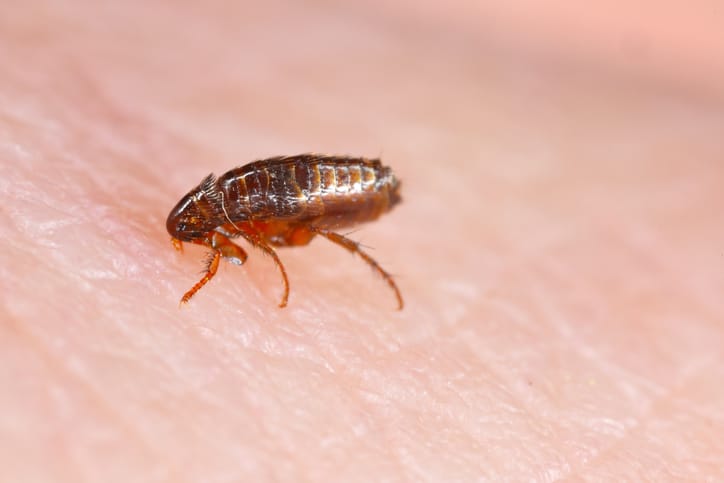We’ve all been there: that tiny black spec…did it just move? If you’re a homeowner, few things can spark panic faster than spotting a flea in your carpet, on your bedding, or crawling on your pet. Fleas are annoying, but they also bite, can spread disease, and turn your home into a source of stress. We’ve compiled the top questions our pest control experts hear about fleas, along with their best answers. All to help you protect your home, family, and pets.
Top Flea Questions Answered by Pest Pros
At Ford’s Hometown Services, we’ve been helping homeowners protect their homes from fleas since 1941. Here are eight common flea questions our technicians get, along with expert answers.
1. What are fleas?
Fleas are tiny, dark brown insects about the size of a sesame seed. They don’t have wings, but their strong legs let them jump surprisingly far. Fleas survive by feeding on blood, which is why they’re more than just annoying: they can quickly become a problem for your family.
2. How do I know if I have fleas?
If you have pets, watch for excessive scratching, licking, or biting. Around the house, check carpets, rugs, or bedding for tiny dark specs, often called flea dirt. Adult fleas are fast and jump quickly, so you might even catch them in action. If you’ve been bitten, you’ll likely notice small, itchy red bumps, usually around the ankles or legs.
3. How do fleas spread?
Fleas lay eggs in your pet’s fur, and those eggs can fall into carpets, rugs, cracks, and bedding. For every adult flea you see, there are usually dozens more eggs and larvae hiding. Adult fleas live about 2-3 months, but eggs and larvae in carpets can survive longer, which is why infestations can persist even after cleaning. Fleas can hitch a ride inside on pets, wildlife like raccoons or squirrels, or even your clothing, making infestations easy to start before you notice.
4. Are fleas common?
Fleas are very common. There are over 2,000 flea species worldwide and more than 300 species right here in the U.S. The most common flea in New England is the cat flea. Despite its name, the cat flea feeds on dogs, cats, and other wildlife, too.
5. Are fleas dangerous?
Most of the time, fleas are more of a nuisance than a serious threat. Their bites can be itchy and irritating, but in rare cases, fleas can carry germs that affect people or pets. According to the CDC, fleas can transmit typhus or cat scratch disease, which is why managing infestations promptly is important.
6. How can I prevent fleas?
- Work with your veterinarian to use a proven flea treatment on your pets.
- Keep your home clean: vacuum and wash bedding regularly.
- Seal entry points and consider residential pest control, as fleas can hitch a ride on rodents or wildlife.
7. Are flea infestations a sign of poor hygiene?
Not at all. Fleas often enter homes on pets, and then settle in a warm, cozy spot. While clutter can give them more hiding places, having a flea problem doesn’t mean your home is dirty. Even the cleanest homes can face an infestation.
8. How do I know if I need professional flea control?
If fleas keep coming back despite regular cleaning and over-the-counter treatments, it’s time to call in the pros.
Professional flea control can:
- Target all stages of the flea lifecycle
- Treat hard-to-reach areas
- Help prevent future infestations
At Ford’s Hometown Services, we offer two popular options:
- Outdoor-only service: Focuses on shaded areas, pet hangout spots, and property edges where fleas are most likely to breed.
- Indoor and outdoor service: Provides comprehensive treatment for homes needing extra protection.
With the right approach, you can protect your pets, family, and home while keeping your space comfortable and flea-free.
Protect Your Home, Pets, and Family from Fleas
Fleas are stubborn. If you find them in your home, don’t let them take over. At Ford’s Hometown Services, our professional flea control treatments are designed to eliminate infestations and prevent them from coming back. Whether you need outdoor-only service or comprehensive indoor and outdoor protection, we’ve got you covered. Call today at (508) 459-3695 or get a quote online, and let’s make your home flea-free!

